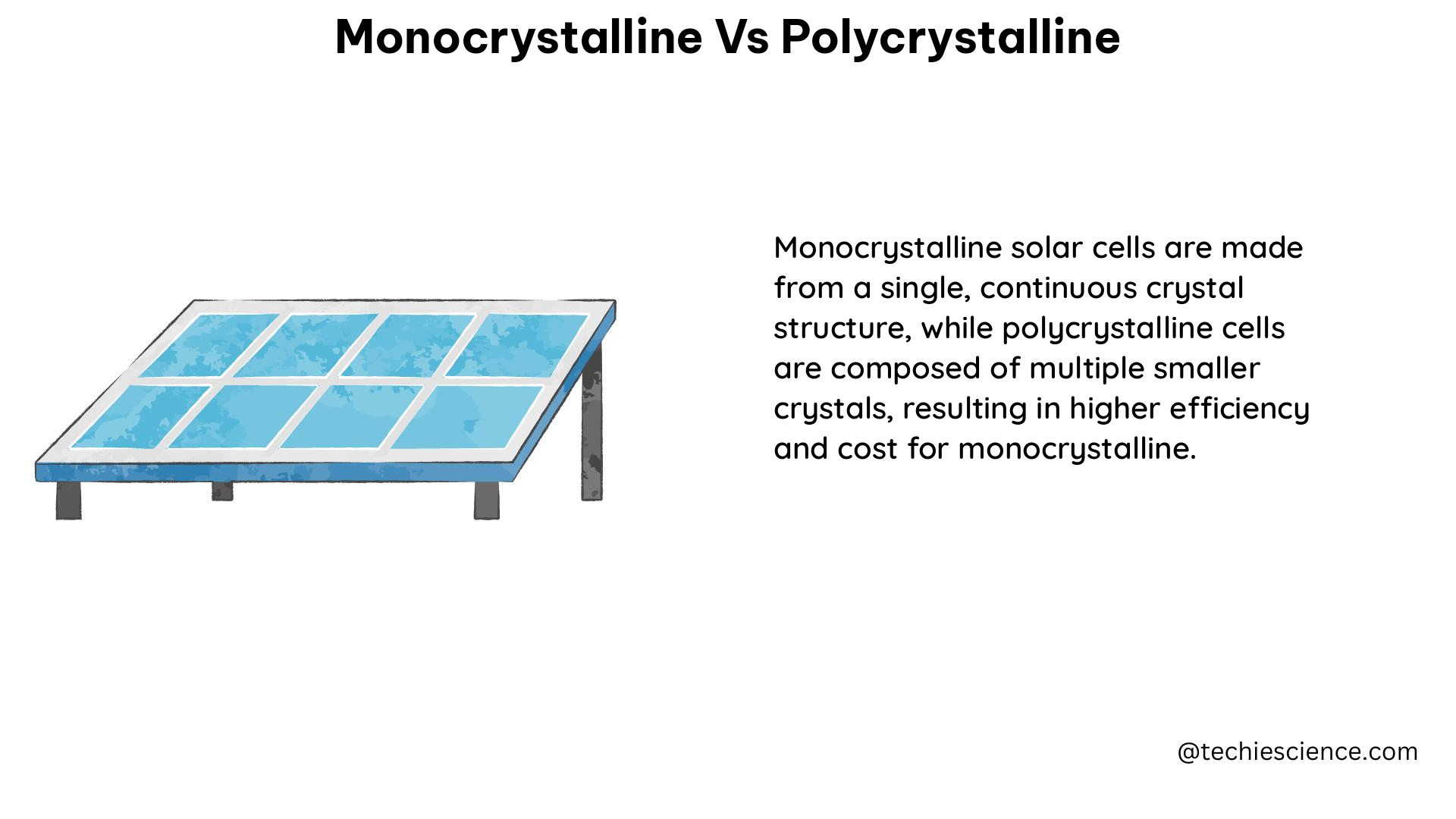Monocrystalline and polycrystalline solar panels are the two most common types of solar panels used for residential installations. These two solar panel technologies differ in their manufacturing process, appearance, efficiency, temperature coefficient, cost, and lifespan, making them suitable for different applications and budgets.
Manufacturing Process
Monocrystalline Solar Panels:
Monocrystalline solar panels are manufactured using a single silicon crystal, which is grown from a pure silicon seed crystal. This process, known as the Czochralski process, results in a uniform, high-purity silicon crystal that is then sliced into thin wafers. These wafers are then assembled into solar cells and encased in a protective frame to create the final monocrystalline solar panel.
Polycrystalline Solar Panels:
Polycrystalline solar panels are made from multiple silicon fragments that are melted and cast into square ingots. These ingots are then sliced into thin wafers, which are assembled into solar cells and encased in a protective frame to create the final polycrystalline solar panel.
Appearance

Monocrystalline Solar Panels:
Monocrystalline solar panels have a uniform black color, which is a result of the high-purity silicon used in their manufacturing process. This uniform appearance is often considered more aesthetically pleasing than the speckled blue color of polycrystalline solar panels.
Polycrystalline Solar Panels:
Polycrystalline solar panels have a distinctive speckled blue color, which is a result of the multiple silicon fragments used in their manufacturing process. This speckled appearance can be less visually appealing to some homeowners compared to the uniform black color of monocrystalline solar panels.
Efficiency
Monocrystalline Solar Panels:
Monocrystalline solar panels typically have a higher efficiency rate, ranging from 15% to 20%. This higher efficiency is due to the high-purity silicon used in their manufacturing process, which allows for better electron flow and energy conversion.
Polycrystalline Solar Panels:
Polycrystalline solar panels have a lower efficiency rate, typically ranging from 13% to 16%. This lower efficiency is due to the multiple silicon fragments used in their manufacturing process, which can result in some energy loss during the electron flow and energy conversion process.
Temperature Coefficient
Monocrystalline Solar Panels:
Monocrystalline solar panels have a lower temperature coefficient, typically ranging from -0.26% to -0.35% per degree Celsius. This means that monocrystalline solar panels perform better in warm weather conditions, as their power output is less affected by high temperatures.
Polycrystalline Solar Panels:
Polycrystalline solar panels have a higher temperature coefficient, typically around -0.5% per degree Celsius. This means that polycrystalline solar panels are more sensitive to high temperatures and their power output can be more significantly affected by warm weather conditions.
Cost
Monocrystalline Solar Panels:
Monocrystalline solar panels are generally more expensive than polycrystalline solar panels, with a cost range of $1 to $1.50 per watt. This higher cost is due to the more complex manufacturing process and the use of high-purity silicon.
Polycrystalline Solar Panels:
Polycrystalline solar panels are typically more affordable than monocrystalline solar panels, with a cost range of $0.90 to $1 per watt. This lower cost is due to the simpler manufacturing process and the use of less expensive silicon fragments.
Lifespan
Monocrystalline Solar Panels:
Monocrystalline solar panels have a longer lifespan, typically coming with a 25-year warranty and projected to last substantially longer than 25 years. This extended lifespan is due to the high-quality materials and manufacturing process used in their production.
Polycrystalline Solar Panels:
Polycrystalline solar panels also come with a 25-year warranty, but they may not last as long as monocrystalline solar panels. While polycrystalline solar panels are durable and long-lasting, they may not have the same level of longevity as their monocrystalline counterparts.
Measurable Data Comparison
Here’s a table comparing the key measurable data points between monocrystalline and polycrystalline solar panels:
| Factor | Monocrystalline | Polycrystalline |
|---|---|---|
| Efficiency | 15-20% | 13-16% |
| Temperature Coefficient | -0.26% to -0.35% per °C | -0.5% per °C |
| Cost | $1 to $1.50 per watt | $0.90 to $1 per watt |
| Lifespan | 25 years and longer | 25 years and longer |
| Appearance | Uniform black color | Speckled blue color |
Conclusion
In summary, monocrystalline solar panels offer higher efficiency, better performance in warm weather, and a longer lifespan compared to polycrystalline solar panels. However, they are also more expensive. Polycrystalline solar panels, on the other hand, have a lower efficiency rate, perform worse in high temperatures, and may not last as long as monocrystalline solar panels, but they are more affordable.
The choice between monocrystalline and polycrystalline solar panels ultimately depends on the homeowner’s personal preferences, space constraints, and financial considerations. By understanding the key differences between these two solar panel technologies, homeowners can make an informed decision that best suits their needs and budget.
References:
– Monocrystalline vs. Polycrystalline Solar Panels: Which is Better?
– Monocrystalline vs. Polycrystalline Solar Panels: Which Should You Choose?
– Monocrystalline vs. Polycrystalline Solar Panels: What’s the Difference?
– Mono vs. Poly: Which Solar Panels are Better?

The lambdageeks.com Core SME Team is a group of experienced subject matter experts from diverse scientific and technical fields including Physics, Chemistry, Technology,Electronics & Electrical Engineering, Automotive, Mechanical Engineering. Our team collaborates to create high-quality, well-researched articles on a wide range of science and technology topics for the lambdageeks.com website.
All Our Senior SME are having more than 7 Years of experience in the respective fields . They are either Working Industry Professionals or assocaited With different Universities. Refer Our Authors Page to get to know About our Core SMEs.